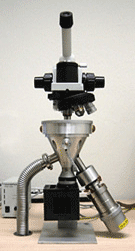Cathodoluminescence microscope

A cathodoluminescence (CL) microscope combines methods from electron and regular (light optical) microscopes. It is designed to study the luminescence characteristics of polished thin sections of solids irradiated by an electron beam.
Using a cathodoluminescence microscope, structures within crystals or fabrics can be made visible which cannot be seen in normal light conditions. Thus, for example, valuable information on the growth of minerals can be obtained. CL-microscopy is used in geology, mineralogy and materials science (rocks, minerals, volcanic ash, glass, ceramic, concrete, fly ash, etc.).

CL color and intensity are dependent on the characteristics of the sample and on the working conditions of the electron gun. Here, acceleration voltage and beam current of the electron beam are of major importance. Today, two types of CL microscopes are in use. One is working with a "cold cathode" generating an electron beam by a corona discharge tube, the other one produces a beam using a "hot cathode". Cold-cathode CL microscopes are the simplest and most economic type. Unlike other electron bombardment techniques like electron microscopy, cold cathodoluminecence microscopy provides positive ions along with the electrons which neutralize surface charge buildup and eliminate the need for conductive coatings to be applied to the specimens. The "hot cathode" type generates an electron beam by an electron gun with tungsten filament. The advantage of a hot cathode is the precisely controllable high beam intensity allowing to stimulate the emission of light even on weakly luminescing materials (e.g. quartz – see picture). To prevent charging of the sample, the surface must be coated with a conductive layer of gold or carbon. This is usually done by a sputter deposition device or a carbon coater.
CL systems can also be attached to a scanning electron microscope. These devices are expensive and are traditionally used for special applications like e.g. investigations in materials sciences or quality determination of ceramics. The most prominent advantage is their higher magnifications. However, CL colour information can only be obtained by a spectroscopic analysis of the Luminescence emission.
Direct viewing of emission colors is only provided by optical CL microscopes, both "cold" and "hot" cathode types.
Local density of photonic states probed by CL
Beyond the material composition, cathodoluminescence microscopy can be used to structures made of known materials, but with rich combinations of these. In this case, CL is capable of measuring the Local density of states (LDOS) of a nanostructured photonic medium, where the intensity of the emitted CL reflects directly the number of available photonic states. This is very relevant for materials like photonic crystals or complex topologies for which large LDOS variations are achieved on nanometer scales.
On the other hand, LDOS variations should be taken into account when analyzing standard CL maps.
References
- Richter, D.K.; Goette, T.; Goetze, J.; Neuser, R. D. (2003). "Progress in application of cathodoluminescence (CL) in sedimentary petrology". Mineralogy and Petrology. 79 (3–4): 127–166. Bibcode:2003MinPe..79..127R. doi:10.1007/s00710-003-0237-4.
External links
- Scientists shed light on glowing materials CL probes the photonic LDOS